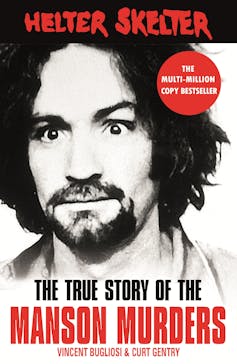Helter Skelter is the bestselling true crime book of all time – but how true is it?
- Written by Sally Breen, Senior Lecturer in Writing and Publishing, Griffith University

Approaching midnight on August 8, 1969, an old Ford left Spahn Ranch, an abandoned Western movie set outside Los Angeles. The ramshackle commune housed a group of misfits and renegades who would come to be known globally as the Manson family.
There were four people in the car: Charles “Tex” Watson and three women, Susan Atkins, Patricia Krenwinkle and Linda Kasabian.
Nearly all media reports state emphatically that Charles Manson, self-styled leader of the clan, had ordered them to drive to 10050 Cielo Drive in the Hollywood Hills and murder everyone there “as gruesomely as you can”. But accounts of how and why that night came to pass differ wildly. The stories changed even at trial.
What we do know is that five people were savagely murdered that night.
Steve Parent, a young friend of the caretaker, was shot by Watson four times in the chest and stomach. He was sitting his car, about to leave. Sharon Tate, pregnant wife of movie director Roman Polanski, was tied up and stabbed 16 times. Watson wrote “PIG” on the front door in her blood.
Abigail Folger, heiress to the Folger coffee fortune, had been in bed reading when Susan Atkins passed by the room, searching for occupants. She waved. Later, Folger tried to escape via the pool area. She was stabbed 28 times.
Wojciech Frykowski, Folger’s partner and a friend of Polanski’s, fought hard. He was beaten over the head repeatedly with the butt of a gun, shot twice and stabbed 51 times. Celebrity hairdresser Jay Sebring, who tried to intervene on his former girlfriend Tate’s behalf, was shot and stabbed seven times.
First responders described seeing the bodies of Folger and Frykowksi in the garden. “They looked like mannequins that had been dipped in red paint, then tossed haphazardly on the grass.”
On August 10, 1969, the old Ford left Spahn Ranch again. This time Charles Manson was with them. The hunt was on. Leno and Rosemary LaBianca’s house was selected at random. Manson remembered the street in Griffith Park because the crew had partied many times at a house across the way. It seemed poor form to attack that house, so they chose 3301 Waverley Drive instead.
When they went inside, a big dog licked Manson’s hand. Watson carved “War” with a bayonet into Leno’s stomach. Krenwinkle used the victim’s blood to write “Rise” and “Death to Pigs” on walls and “Healter Skelter” (a misspelling of “Helter Skelter”) over the refrigerator.
Manson later told journalist Nuel Emmons that while he’d been inside and had helped tie up Rosemary and Leno, who were both murdered, their compliance meant he couldn’t go through with the killing. “Somehow I just couldn’t make the first move.”
Charles Manson is arguably America’s most infamous murderer of the modern era. Except he didn’t kill any of the people he was convicted of killing. What sank him wasn’t hard evidence of his perpetration. Instead, the pervasive power of male persuasion – his own and that of prosecuting attorney in the Tate-LaBianca murder trial, Vincent Bugliosi – set both his downfall and his mythic rise into motion.
Read more: In Killers of the Flower Moon, true crime reveals the paradoxes of the past
‘An uncomfortable experience’
Re-reading Helter Skelter (1974), the book Bugliosi co-wrote (with Curt Gentry) about the murders and the trial, has been an uncomfortable experience. And not in the ways I expected.





